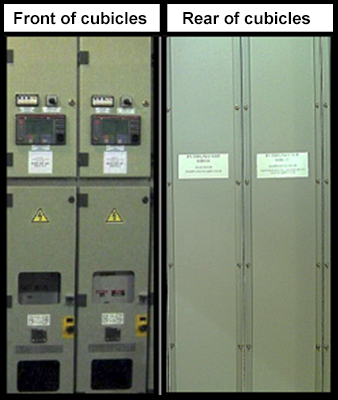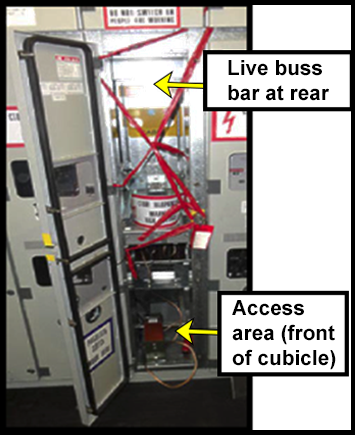-
What happened?
Two electricians had to remove a cable current transformer at the base of cubicle 13 to terminate and gland a 6kV cable.
They needed to open cubicle 12 to pull a contactor but required a special key.
Rather than wait for the key, they obtained approval to access the cable through the front panel of cubicle 13.
Due to tight space, they also removed the back panel. This exposed them to an insulated live busbar, energised with 6kV electricity, with the potential of an arc flash.

-
Why did it happen?
Space was tight. They wanted to get the job done, so removed the back panel.
There was no ‘Danger - high voltage’ warning label.
The electricians changed the task without verifying the system has been de-energised.
They had permission to remove the front panel, but not the rear panel.

-
What did they learn?
Always verify ‘zero energy’ before starting work.
Use energy isolation or ‘lock out/tag out’ to mitigate exposure to shock hazards.
When testing energised circuits, create a work plan and use approved:
- test devices;
- personal protective equipment (leather gloves, arc flash garments);
- isolated tools.
Follow approved energisation procedures and alerting/awareness techniques.

-
Ask yourself or your crew
Think of a time you changed the plan to get the job done. What could have happened?
How can something like this happen here?
What could they have done differently?
What barriers/controls do we have that could have prevented this? How can they be improved?
Who is checking that the permit-to-work conditions are being met in the field?

Add to homescreen
Content name
Select existing category:
Content name
New collection
Edit collection
What happened?
Two electricians had to remove a cable current transformer at the base of cubicle 13 to terminate and gland a 6kV cable.
They needed to open cubicle 12 to pull a contactor but required a special key.
Rather than wait for the key, they obtained approval to access the cable through the front panel of cubicle 13.
Due to tight space, they also removed the back panel. This exposed them to an insulated live busbar, energised with 6kV electricity, with the potential of an arc flash.

Why did it happen?
Space was tight. They wanted to get the job done, so removed the back panel.
There was no ‘Danger - high voltage’ warning label.
The electricians changed the task without verifying the system has been de-energised.
They had permission to remove the front panel, but not the rear panel.

What did they learn?
Always verify ‘zero energy’ before starting work.
Use energy isolation or ‘lock out/tag out’ to mitigate exposure to shock hazards.
When testing energised circuits, create a work plan and use approved:
- test devices;
- personal protective equipment (leather gloves, arc flash garments);
- isolated tools.
Follow approved energisation procedures and alerting/awareness techniques.
Ask yourself or your crew
Think of a time you changed the plan to get the job done. What could have happened?
How can something like this happen here?
What could they have done differently?
What barriers/controls do we have that could have prevented this? How can they be improved?
Who is checking that the permit-to-work conditions are being met in the field?
Two electricians were exposed to a 6KV live busbar while removing a cable current transformer. The near miss occurred because they changed the task without verifying the system has been de-energised.














